In Jocelyn’s The Life of St Kentigern there is a story about the saint’s recall from Wales to the Old North by Glasgow’s ruler, Rhydderch Hael. Following an angelic vision, Kentigern sets out with 665 disciples and arrives in Hoddom where he is greeted by a multitude of people.
Drawing a cross and invoking the Holy Trinity, Kentigern orders anyone against the word of God to depart. This results in ‘a vast multitude of skeleton-like creatures, horrible in form and aspect’ departing from the assemblage and fleeing from sight.
Reassuring the terrified crowd Kentigern ‘lays bare’ what they believe in. He condemns their idols to the fire and tells them their principal deity ‘Woden’ from whom they claim descent is nothing more than a mortal man of a pagan sect whose body is ‘loose in the dust’ whilst his soul ‘endures the eternal fire’ in the underworld.
As Kentigern preaches faith in Jesus Christ the flat plain of ‘Hodelm’ rises into a hill which remains to this day. The people ‘renounce Satan’ and are washed in the waters of baptism.
This foundation legend explains the association of the site of the church and the graveyard beside the river Annan across from Woodcock Air (the hill) at Hoddom with St Kentigern.
The Life of St Kentigern was commissioned by Jocelyn, Bishop of Glasgow, and written by Jocelyn, a monk of Furness, in the 12th century. As a literary hagiography it was clearly designed to promote the life of Kentigern (who lived in the 6th century) and vilify paganism. As a historical document it should be approached with caution, particularly in light of the anachronism concerning Woden.
Whilst there is archaeological evidence of a Northumbrian monastery based around St Kentigern’s church at Hoddom it was not founded until the 8th century. (This is evidenced by an 8th century letter sent by Alcuin to Wolfhard, Abbott of Hodda Helm). The Anglo-Saxons did not arrive until long after Kentigern died. It seems Jocelyn wove later tales concerning the conversion of Woden’s worshippers into the text.
This leaves us with the question of who the people of Hoddom venerated prior to Kentigern’s arrival. The existence of a local cult is evidenced by a Roman altar stone found in the wall of the church at Hoddom Cross and built into the porch in 1817. Unfortunately when it was found the sides could not be seen and the ‘mouldings of the capital and base’ had been ‘dressed off’. There are no clues who it was dedicated to.
However the surrounding area echoes with pagan memories: the place-names Brydekirk and Lochmaben; an altar to Vitris and a ram’s head at Netherby; the story of Gwenddolau, the last pagan Brythonic king, whose soul was gathered by Gwyn ap Nudd after he was killed at the Battle of Arfderydd. Myrddin Wyllt’s flight from Arfderydd in battle-madness to Celyddon.
Intrigued and troubled by the story of Kentigern’s conversion of the people of Hoddom, wondering whether between the lines and beneath the Hollywood-style Biblical pyrotechnics any ‘truths’ (or at least personal gnoses) about their pagan religion may be intuited from the land, I returned to the area North of the Wall.
Walking from Ecclefechan to Hoddom, the first thing that struck me was the teeming of nature in the Scottish villages and fields. Flocks of spotted starlings on the roofs and telephone wires. Droves of sparrows flitting in and out of the hedgerows. The un-mowed roadsides were alive with flowers and every flower was covered with bees. Slick black slugs wandered through long grasses. I felt an unusual liberty in ‘the right to roam’.
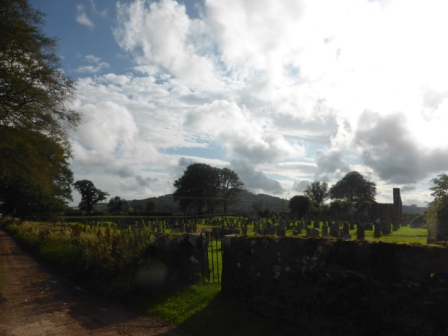 My first stop was at the church at Hoddom Cross. Roofless and derelict due to a fire, ivy climbed its walls and mausoleums. Ferns and wildflowers pushed through the railings to adorn older graves marked by sandstone gravestones. Newer graves with shiny porcelain headstones adorned with freshly wrapped bouquets glimmered in the background.
My first stop was at the church at Hoddom Cross. Roofless and derelict due to a fire, ivy climbed its walls and mausoleums. Ferns and wildflowers pushed through the railings to adorn older graves marked by sandstone gravestones. Newer graves with shiny porcelain headstones adorned with freshly wrapped bouquets glimmered in the background.
Something birch-white caught my eye. Going to investigate I found myself blinking in disbelief. In a Christian graveyard a couple of miles from any village I was staring at what to all appearances was a carving of a white dog with a purposively painted red nose. Dormach red-nose! I thought immediately of Gwyn ap Nudd’s famous hound who accompanies him as he guides the dead to the otherworld.
Admittedly it had antler-like twigs for ears and might have been a representation of Rudolph the red-nosed reindeer. But why carve it white from birch? It looked far more like a dog and a hound of Annwn at that. Too strange a find in a graveyard to be pure coincidence when I was tracing the deity(s) associated with the Roman altar (which I did not see).
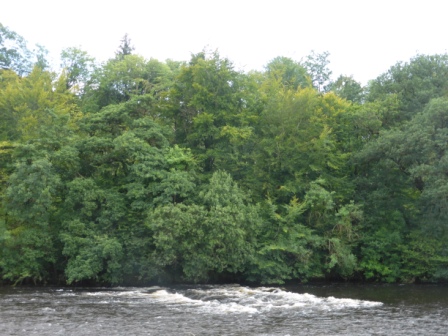 After visiting the ‘new’ church I walked to St Kentigern’s graveyard at Hoddom across the Annan from Woodcock Air. Watched over by a tall fir (or pine?) tree it was blissfully overgrown with ferns, yarrow, willowherb, bee-humming knapweed, decorated by harebells.
After visiting the ‘new’ church I walked to St Kentigern’s graveyard at Hoddom across the Annan from Woodcock Air. Watched over by a tall fir (or pine?) tree it was blissfully overgrown with ferns, yarrow, willowherb, bee-humming knapweed, decorated by harebells.
Wandering amongst the gravestones I noticed carved images of skulls and crossbones and remarkable winged souls which a notice recorded as ’18th century folk art’. So here are Kentigern’s skeletons, I thought, unbanished. Symbols of death and our transition to the otherworld living on through years of Christian rule.
From the vantage point on Woodcock Air as I looked down on St Kentigern’s graveyard the sandstone gravestones shifted into brown-clad people. I gained a sense of the slowness of lives decanted by prayer, steady seasonal work in the fields, the slow turning of cart wheels, the satisfaction of self-subsistency and knowing you would die and be buried in your land close to your community.
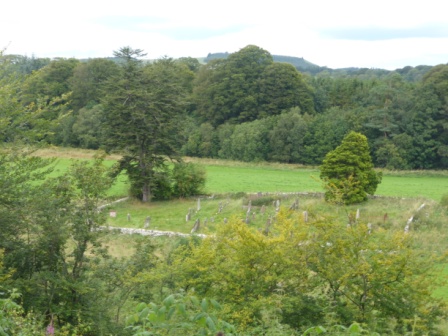 And beneath the Northumbrian monastery did I gain a sense of St Kentigern’s church? The scene of conversion? The deity(s) to whom the ‘idols’ were dedicated? The ‘truth’ felt buried deep. Momentarily seeing the raised area where the church stood as a burial mound I thought back to Jocelyn’s words about ‘Woden’ being a mortal man of a pagan sect whose body is in the dust whilst his soul ‘endures the eternal fire’ in the underworld.
And beneath the Northumbrian monastery did I gain a sense of St Kentigern’s church? The scene of conversion? The deity(s) to whom the ‘idols’ were dedicated? The ‘truth’ felt buried deep. Momentarily seeing the raised area where the church stood as a burial mound I thought back to Jocelyn’s words about ‘Woden’ being a mortal man of a pagan sect whose body is in the dust whilst his soul ‘endures the eternal fire’ in the underworld.
Could these words be read obliquitously to refer to a deified ancestor or ancestral deity believed to live on in the brightness of the world beyond this world? Perhaps even to Gwyn who as a psychopomp and leader of ‘the Wild Hunt’ is Woden’s closest Brythonic equivalent?
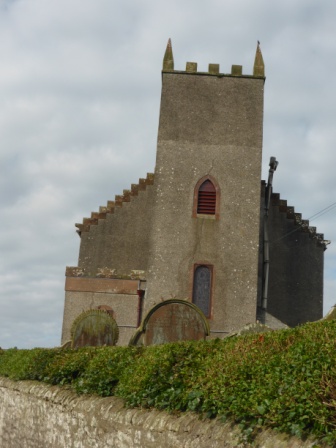 I also had the opportunity to visit Brydekirk. Intriguingly Ronald Cunliffe Shawe claims Gwenddolau worshipped ‘Woden’ and ‘a fire goddess’. His reference leads to the passage about Woden in The Life of St Kentigern. I can’t find anything mentioning a fire goddess. However Gwenddolau’s worship of such a deity would make perfect sense if Brydekirk is named after Bride or Brigid. Brigid was later venerated as St Brigid and her priestesses tended an eternal flame.
I also had the opportunity to visit Brydekirk. Intriguingly Ronald Cunliffe Shawe claims Gwenddolau worshipped ‘Woden’ and ‘a fire goddess’. His reference leads to the passage about Woden in The Life of St Kentigern. I can’t find anything mentioning a fire goddess. However Gwenddolau’s worship of such a deity would make perfect sense if Brydekirk is named after Bride or Brigid. Brigid was later venerated as St Brigid and her priestesses tended an eternal flame.
At the church I was told by one of the parishioners it was indeed named after St Brigid of Ireland. I also learnt St Bryde’s Well was a natural spring and was gifted with an indispensable description of its location.
My walk to the well down the Annan then alongside fields was accompanied by a curious herd of cows who followed peeping out through gaps in the hedge. Their strange behaviour led me to recall the story of how St Brigid was raised by a white cow with red ears: another otherworldly animal.
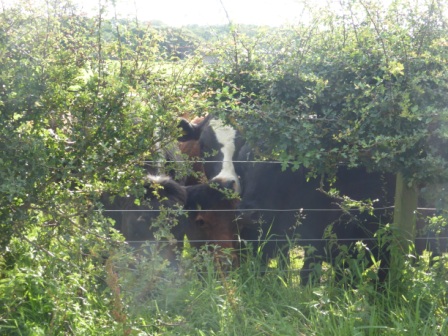 The area surrounding St Bryde’s Well was hopelessly overgrown with brambles, nettles and Himalayan Balsam. With the guidance of the parishioners I still couldn’t find it. Ready to give up I saw what looked like a pink veil. I first assumed it was a votive offering marking the spring. When I got closer I realised it was a balloon strung with pale gauze. Another extraordinary marker that proved to be no mere coincidence.
The area surrounding St Bryde’s Well was hopelessly overgrown with brambles, nettles and Himalayan Balsam. With the guidance of the parishioners I still couldn’t find it. Ready to give up I saw what looked like a pink veil. I first assumed it was a votive offering marking the spring. When I got closer I realised it was a balloon strung with pale gauze. Another extraordinary marker that proved to be no mere coincidence.
Turning round, I noticed a water dispenser and beyond heard running water. Seeing a rivulet at the bottom of a steep bank running into the Annan, I followed its course to find a small stream leading to the natural spring pouring from amongst mosses and ferns into an orangey circular basin: St Bryde’s Well.
Across the river I also visited the remains of St Bryde’s tower. All I found was a single flight of steps climbing upward into the fire of the sun. Could this has have been a stairway walked by Brigid’s priestesses who maintained her eternal flame?
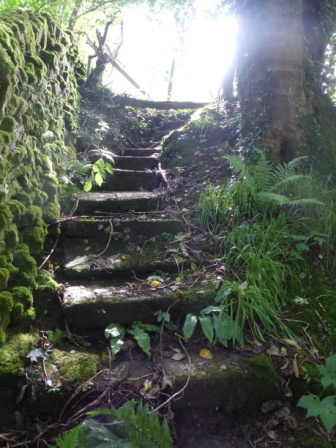 I returned to Penwortham with no clear answers about how or whether St Kentigern converted the people of Hoddom or what they experienced and believed. Such ‘truths’ can only be conjectural and are always determined by our questions, assumptions and beliefs.
I returned to Penwortham with no clear answers about how or whether St Kentigern converted the people of Hoddom or what they experienced and believed. Such ‘truths’ can only be conjectural and are always determined by our questions, assumptions and beliefs.
What I gained was a deeper understanding of how our physical and literary landscapes interweave. How sign and signified lead the dance of a journey which is led by the gods who lead us to places where all distinctions break down in the numinosity of their presence.
At Hoddom and Brydekirk I met a myriad inhabitants of a northern land and I met Gwyn and Bride (who I know here in Lancashire as Brigantia) in new ways. I learnt that within the land and its stories and even in the most depredatory of Christian texts the fire of the gods endures.

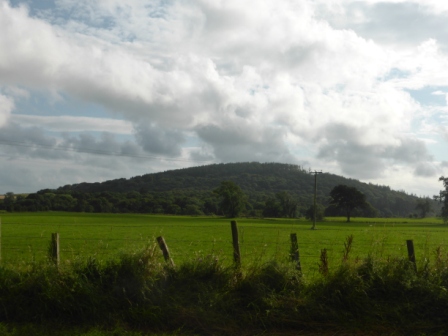








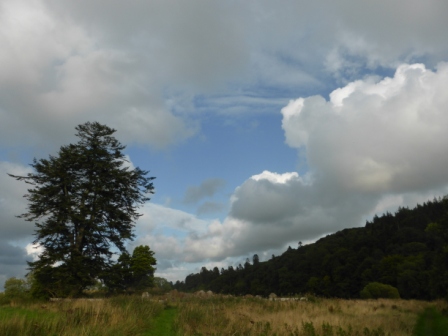







and so may it last
Fascinating to follow your quest. As with many saints lives which contain earlier mythological or legendary material, the story of St Kentigern with its wild man story is a strange mix of confused references to genuine earlier tales and a christianising gloss that garbles the significance of the stories it tells. Sometimes it’s all we’ve got, though the Myrdiin Wyllt legend provides a less ideological slant on the material here with this tale as an interesting parallel. And more besides, as you have identified!
I’m currently in the ‘Old North’ myself on quite another quest. Of which more anon …
Thanks for your comments, Heron. A visit to Drumelzier to follow up the Myrddin Wyllt fragments in The Life of St Kentigern is hopefully going to be one of my next ports of call. I’ll look forward to hearing about your journey to the Old North 🙂 Are you going to be able to make Potia’s Epona rite in Glasgow by the way? I’m hoping to go up and spend some time in Glasgow and Dumbarton as part of my research whilst I’m there.
Good luck with your explorations of Lailoken in the Tweed valley. That area is rich in legend. I went there a few years back to visit the Eildon Hills a bit further east along the Tweed where Thomas the Rhymer was carried off by the Queen of Faery.
I don’t think I’ll be able to get to Glasgow in October but Potia has sent me the text and I’ll be there in spirit and follow the rite simultaneously.